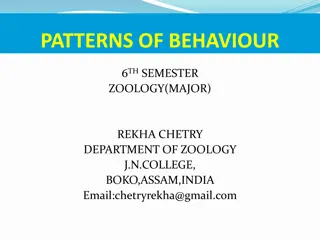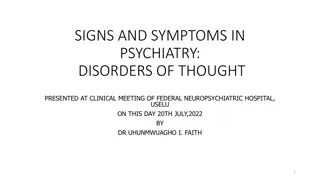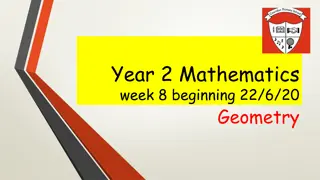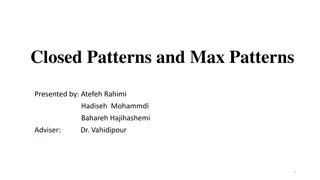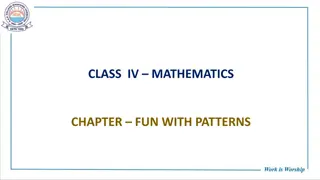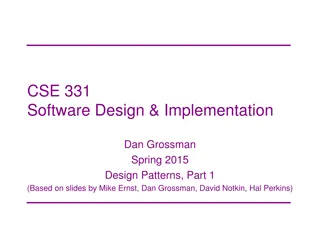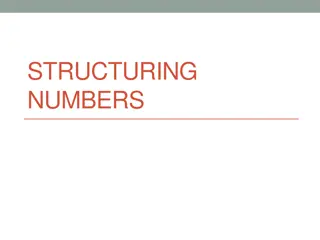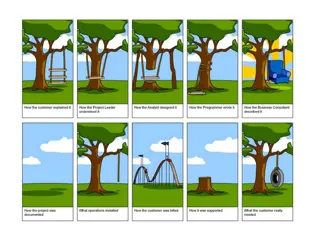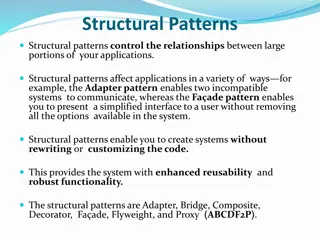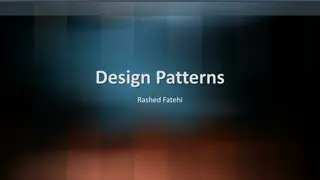Understanding Common Thought Patterns in Communication
Common thought patterns in communication help structure messages effectively to increase understanding and engagement. Recognizing these patterns benefits readers by enhancing comprehension, engagement, recall, and writing skills. The five most common thought patterns are list, sequence, definition, comparison/contrast, and cause/effect. Mixed patterns are prevalent as they add complexity and variety to longer pieces of writing. Examples illustrate how mixed patterns are used to convey information in an organized and engaging manner.
Download Presentation

Please find below an Image/Link to download the presentation.
The content on the website is provided AS IS for your information and personal use only. It may not be sold, licensed, or shared on other websites without obtaining consent from the author. Download presentation by click this link. If you encounter any issues during the download, it is possible that the publisher has removed the file from their server.
E N D
Presentation Transcript
Common Thought Patterns
Whats the big deal about thought patterns? There are common ways communicators speakers or writers structure their messages so that they increase the chance of being understood. These conventional structures or common organizations are often called thought patterns because the convincing spoken or written word is most effectively first organized in thought. If you recognize them, you will benefit in many ways!
What benefits come to readers who recognize common thought patterns? 1) Increased comprehension! You will catch on more quickly and understand more fully the author s message. 2) Increased engagement! you will be busy anticipating what is coming next in the pattern. 3) Better recall! Because you saw the pattern, you will know what to study. You will also more easily recall what you studied because your thoughts will be organized. 4) Improved writing! You will be able to more effectively use patterns in your own writing to communicate better.
What are the 5 Most Common Patterns? 1) list 2) sequence (order) 3) definition 4) comparison/contrast 5) cause/effect
Why is MIXED Pattern most common? It is unusual to find one of the five common patterns appearing alone throughout an entire paragraph. There is often an overall organizational pattern for a longer piece. For example, how are your textbooks chapters organized? Simplest concepts to most complex? College-level text often involves mixed patterns to achieve complexity and variety, which makes reading more interesting for adults (though a bit more challenging/complex).
Examples of Mixed Patterns EXAMPLE 1 I was almost late to class this morning because I didn t hear my alarm clock this morning. And if there s one thing I hate, it s feeling rushed. First, I didn t get to take a shower. Then, I didn t get to iron my clothes. I barely caught the bus before it pulled away from the curb. To make matters worse, I had a test and failed to eat any breakfast beforehand. EXAMPLE 2 Jeremy lifted Josephine s head, opened her eyelids, and noticed her pupils were unresponsive to light. Frantically, he felt her wrist and carotid artery for a pulse, but found none. He called 911, and continued CPR until the paramedics arrived. Eventually, he was forced to acknowledge Josephine had died. Why he had he insisted on racing Josephine to the bottom of an extra large slushy was a question that would follow Jeremy for the rest of his life, and it first crossed his mind as the ambulance pulled away with Josephine inside.
What are LIST features? In a list, items can be rearranged in any order, and the intended meaning will remain. Ex. I enrolled in school to learn more about math, science, history and art. versus I enrolled in school to learn about science, art, history and math.
Compare a LIST to a SEQUENCE A sequence is distinctive because it must remain in the original order. Ex. To correctly pitch a tent, first roll out the fabric. Second, put together all of the legs or supports. Guide the supports through the tent fabric and into the four corner pockets so that the fabric stretches and raises. Finally, using a mallet, secure each stability loop by hammering the stakes into the ground.
SEQUENCE, continued Look what happens if you rearrange the steps: To pitch a tent, first guide the supports through the tent fabric and into the four corner pockets so that the fabric stretches and raises. Second, using a mallet, secure each stability loop by hammering the stakes into the ground. Put together all of your legs or supports. Finally, roll out the fabric. Umm looks like I ll be camping in the car!
SEQUENCES often look like LISTS Like a list, a sequence can use a lot of the same signals: first, second, third, finally, a, b, c, or 1., 2., 3. A list or sequence might also use: bulleted items like this The TEST for whether or not you have a list or sequence is to rearrange the list & see if the meaning changes
SEQUENCE (fancy word for order) Orders (or sequences) come in lots of forms: Chronological (time) Spatial (size, distance) Alphabetical Color (shade) Peanut Butter (creamy, semi-chunky, chunky, etc.) How many ways could we order students in a MoHealthWINs class in a line at the door to leave the classroom?
What are features of a DEFINITION? College-level reading involves A LOT of definitions. Pay attention to a singular word of phrase with different publishing features than the rest of the paragraph, like bold, italics, or size change. Also, pay attention to phrases like these: refers to means is, is defined as, or is called
What are features of a COMPARISON/CONTRAST? You will be shown differences and/or similarities between two OR MORE things. It s not always a full analysis of all things similar and different. Ex. A young teenage boy might write an essay on how different he is than his parents. It doesn t mean he doesn t share any similarities with his parents, but the reader will likely be treated a one-sided presentation of differences. It s not always just fries versus baked potato! What about the other sides on the menu? It s not always Obama versus Romney what about the other candidates who ran in the election?
COMPARISON/CONTRAST, continued Pay attention to phrases like these: Similarities: like, same, also, similarly Differences: in contrast, on the other hand, however, but, although, unlike, whereas
What are the features of CAUSE/EFFECT Cause & Effect shows the relationship between two or more things. Pay attention to words/phrases like these: because the cause of it was The effect was As a result Therefore, Consequently, Is due to .
. MoHealthWINs This workforce solution was funded by a grant awarded by the U.S. Department of Labor s Employment and Training Administration. The solution was created by the grantee and does not necessarily reflect the official position of the U.S. Department of Labor. The Department of Labor makes no guarantees, warranties, or assurances of any kind, express or implied, with respect to such information, including any information on linked sites and including, but not limited to, accuracy of the information or its completeness, timeliness, usefulness, adequacy, continued availability, or ownership. This work is licensed under a Creative Commons Attribution 3.0 Unported License.




